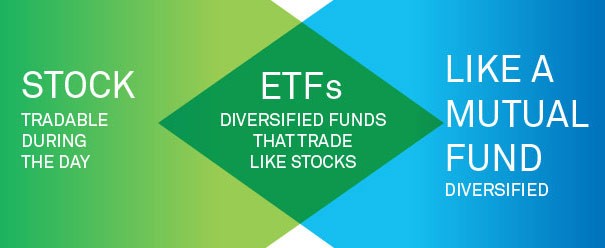ETF Benefits include the best features of stocks and mutual funds
Post on: 7 Апрель, 2015 No Comment

The main ETF Benefits are their low cost, diversification, flexibility, tax efficiency, transparency, and liquidity. Investors in ETFs can access a wide variety of markets, and seek profits during advancing or declining markets, all at a reduced cost compared with mutual funds. ETFs invest in domestic and international stock, bond, and commodities markets using either a passive, index-based investment strategy (replicates the benchmark index) or an active management investment strategy (attempts to outperform the benchmark index).
ETF Benefits #1: Low Cost
ETFs can have an immediate positive impact on an investors portfolio due to their low fees. For example, the average U.S. equity mutual fund charges 1.42 percent in annual expenses, the average equity ETF charges 0.53 percent. ETFs are less expensive than traditional mutual funds because most ETFs are index funds, and index tracking is inherently less expensive than the active management practices of mutual funds.
ETFs are designed to track market indexes that may contain hundreds or even thousands of securities. ETFs invest in every major index, equity style, international region and investable country. ETFs cover specific industries both domestically and globally. ETFs also provide comprehensive access to sub-sectors, fixed-income, and commodities. Unlike stocks or mutual funds, ETFs also provide efficient means to invest in major economies through currency ETFs.
When economic conditions result in financial markets trending downward or sideways for extended periods of time. Exchange Traded Funds called inverse ETFs and leveraged ETFs create opportunities for investors to profit during such periods.
Inverse ETFs are designed to produce the opposite return of their underlying indexes. For example, if the S&P 500 is down 1%, an inverse Exchange Traded Fund tracking the S&P 500 will gain roughly 1%.
The objective of leveraged ETFs is to outperform its index by 2X, 3X and some even offer 4X. Investing in an NASDAQ ETF that uses 2 times leverage will gain 2% for every 1% the index rises. Conversely, if the NASDAQ drops 1%, the inverse ETF will lose 2%. Inverse ETFs are also available in the leveraged version.
Because ETFs seek to track market indexes, their turnover is typically lower than that of actively managed funds. Lower turnover can result in increased tax efficiency for investors when securities are sold at a gain. In addition, with traditional mutual funds, the buying and selling activities of some shareholders can trigger capital gains distributions for all of the funds shareholders. For example when the fund must sell securities to raise cash in order to meet redemptions, any related capital gains are distributed to all remaining investors in the fund.
In contrast to mutual funds, ETF trading occurs on an exchange in the same manner as stocks; there is no fund company middle-man. Thus ETF investors are generally insulated from the tax consequences of their fellow shareholders actions and will primarily be affected when they decide to complete ETF trading by either buying or selling an ETF.
Additionally, ETFs may be an effective way to “harvest” tax losses. When an investor sells a security to realize a tax loss, he or she may be able to purchase a comparable, but not substantially identical, ETF in order to maintain a similar exposure while preserving the tax benefits of the loss.
ETFs are highly transparent, as their holdings are disclosed on a daily basis. With ETFs, investors can understand the exact makeup of their portfolios at any given time. This may be a particularly important feature during periods of market dislocation, or when specific securities or asset classes come under pressure as they have in recent crises.
Exchange Traded Funds (ETFs) draw upon two sources of liquidity: the liquidity of the secondary market where they trade throughout the day at their prevailing market price, as well as the liquidity of the primary market in which more shares can be created or redeemed at the fund’s net asset value (NAV).














